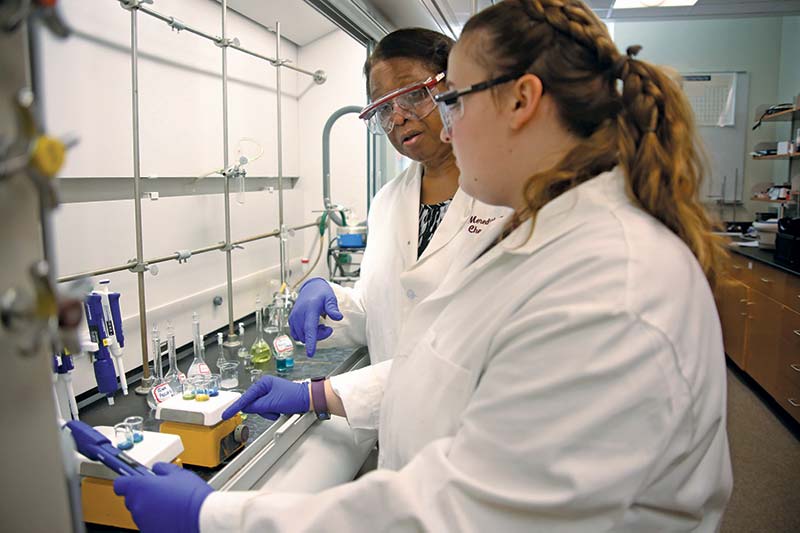Strong Spaces: Walda Powell
- By Reah Nicholson
- Published

Walda Powell
Department Head and Professor of Chemistry, Physics, and Geoscience
Ph.D., M.S., and B.S. in Chemistry
Walda Powell always loved science but chemistry was not her passion. She developed an interest in chemistry when she attended N.C. Governor’s School as a rising senior in high school. An organic chemist taught one of the classes and talked about his life as a pharmaceutical chemist. Powell was hooked.
“I loved science my whole life and was fortunate enough to have parents who supported my interest in doing science projects,” said Powell. “Oftentimes my parents even joined in my efforts. We loved to watch science documentaries, and I read a lot of books on science topics.”
As a synthetic chemist, Powell enjoys making new compounds and is intrigued by trying new synthetic methods. She recently developed an interest in fermentation and would like to pursue research in that area, as she is constantly looking for new research methods.
Powell spends most of her time in her lab, which is one of her favorite places. She describes it as a joyful, peaceful place where she can take some time to work on a synthesis of a compound, troubleshoot a problem, try something new, or sometimes just clean up.
“A lab has been a special place for me since my freshman year of college and it continues to be,” said Powell. Her love for the lab has carried over in the classroom. She designs unique projects for her students to help build on their love for science and research.
Allie Ward, ’17, Georgia Kimbell, ’18, and Lainey Ward, ’18, will take you through the step-by-step process for analyzing apple juice, orange juice, dark spot corrector, foundation, and sunscreen to determine the amount of vitamin C in each product.
“My research lab is a place of learning for my students. It is wonderful to watch students take a project and take ownership in making the project work.”

Make an iron chloride solution. Using a 1-mL and 5-mL micropipette, the desired amount of iron chloride is measured out. Iron chloride is then combined with nitric acid and mixed in a volumetric flask. To ensure the solution is mixed completely, the covered volumetric flask is placed on a vortex.

Solutions are combined to make a color complex, which is used for the analysis of vitamin C. Dilute solutions of apple juice, orange juice, dark spot corrector, foundation, and sunscreen are combined with potassium ferrocyanide and ferric chloride to prepare the color complex.

Each solution is placed on a stir plate for 10 minutes to complete the formation of the complex.

1-cm cuvettes are used to analyze the samples. Each solution is placed in a cuvette and then placed into the UV-Visible Spectrophotometer, which provides the sample’s concentration of vitamin C compared to a standard solution of vitamin C. The goal is to have a linear relationship between the concentration of vitamin C and absorbance of the color complex.

When comparing the complexes to the standard, the darker the color, the more vitamin C.
– Dark Spot Corrector has the most vitamin C. Its turquoise color is the closest to the standard, followed by apple juice.
– Orange juice, the emerald color, came in fourth followed by sunscreen with a greenish color.
– The foundation, which has more of a yellow color, has the least amount of vitamin C.
News Director
316 Johnson Hall
(919) 760-8087
Fax: (919) 760-8330
PRINCETON REVIEW
U.S. NEWS
NICHE
3800 Hillsborough Street Raleigh, NC 27607-5298 | (919) 760-8600 Fax: (919) 760-8330 | © 2024 All Rights Reserved.